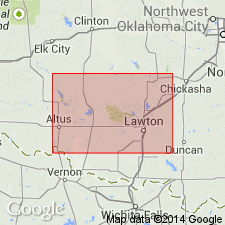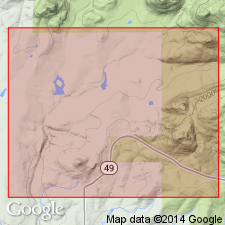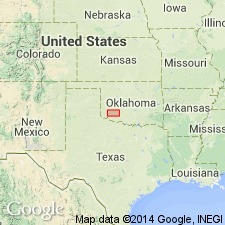
- Usage in publication:
-
- Mt. Scott Granite
- Modifications:
-
- Named
- Dominant lithology:
-
- Granite
- AAPG geologic province:
-
- Palo Duro basin
- South Oklahoma folded belt
Summary:
Named Mount Scott Granite of /Wichita Granite Group [spelled Mt. Scott in this report; changed to Mount Scott in subsequent reports]. Wichita Granite Group is comprised of (oldest to youngest): Mount Scott, Lugert, and Quanah Granites. Mount Scott Granite forms half of the outcrop area in eastern and central parts of Wichita Mountains; was emplaced as an intrusive sheet that must have had an areal extent of hundreds of square miles; outcrops are found in an area of 25 to 35 miles. On accompanying geologic map, Mount Scott is shown to be present in Comanche, Kiowa, Jackson, and northernmost Tillman Counties (S. Oklahoma folded belt province and Palo Duro basin). Formerly mapped as Lugert Granite by Taylor (1915) and Hoffman (1930); writer believes sufficient evidence has accumulated to designate it as a separate granite. Differs from Lugert in that it is granophyric and contains elliptical zoned feldspars. Mount Scott is a medium-grained, slightly porphyritic leucogranite with a low ferromagnesian content, normally less than 5 percent; is salmon-pink in color, speckled with small dark spots on fresh surface, weathers reddish. Is a one-feldspar granite with microperthite being the dominant constituent, and free plagioclase minor or absent. Inclusions of country rock common. Measured thickness 980 feet on Mount Scott, but, as dip of sill is unknown, true thickness may be considerably less. It is the oldest granite in eastern Wichita Mountains. Intrudes Early Cambrian(?) /Raggedy Mountain Granite Group. Is intruded by Lugert Granite in the Snyder area, Kiowa County, and by Quanah Granite in several places in sec. 15, T. 3 N., R. 15 W., Comanche County. Age of Wichita Granite Group is Middle Cambrian(?), approximately 525 m.y., based on isotopic dates provided by Tilton, Wetherill, and Davis (1962). Report includes geologic map, chemical analyses.
Named from Mount Scott, in Comanche Co., OK, which is composed of this granite. Forms half of outcrop area in eastern and central parts of Wichita Mountains.
[Wichita Granite Group preempted by Wichita [Group] of Cummins (1890) in TX; conflicts with nomenclature guidelines stating a group name combines a geographic name with the term "group," and no lithic designation is included (ACSN, 1961, 1970; NACSN, 1983, 2005, 2021).]
Source: GNU records (USGS DDS-6; Denver GNULEX); US geologic names lexicon (USGS Bull. 1350, p. 512).

- Usage in publication:
-
- Mount Scott Granite
- Modifications:
-
- Geochronologic dating
- AAPG geologic province:
-
- Palo Duro basin
- South Oklahoma folded belt
Summary:
Discussion of isotopic-age dates from basement rocks in Oklahoma. Age determination made on biotite from Mount Scott Granite gave 490 +/-20 m.y.
Source: US geologic names lexicon (USGS Bull. 1350, p. 512).

- Usage in publication:
-
- Mount Scott Granite
- Modifications:
-
- Overview
- AAPG geologic province:
-
- Palo Duro basin
- South Oklahoma folded belt
Summary:
Discussion of names and relative ages of granites and rhyolites in Wichita Mountains. Combining conclusions from the mineralogic data, differentiation indices, and field relationships appears to be, Mount Scott (oldest), Headquarters, Reformatory, Lugert, Quanah, and aegirine-riebeckite granite dikes (youngest). Cold Springs Granite is a hybrid rock formed by the assimilation of the basic rocks by Mount Scott Granite.
Source: US geologic names lexicon (USGS Bull. 1350, p. 512).
For more information, please contact Nancy Stamm, Geologic Names Committee Secretary.
Asterisk (*) indicates published by U.S. Geological Survey authors.
"No current usage" (†) implies that a name has been abandoned or has fallen into disuse. Former usage and, if known, replacement name given in parentheses ( ).
Slash (/) indicates name conflicts with nomenclatural guidelines (CSN, 1933; ACSN, 1961, 1970; NACSN, 1983, 2005, 2021). May be explained within brackets ([ ]).

